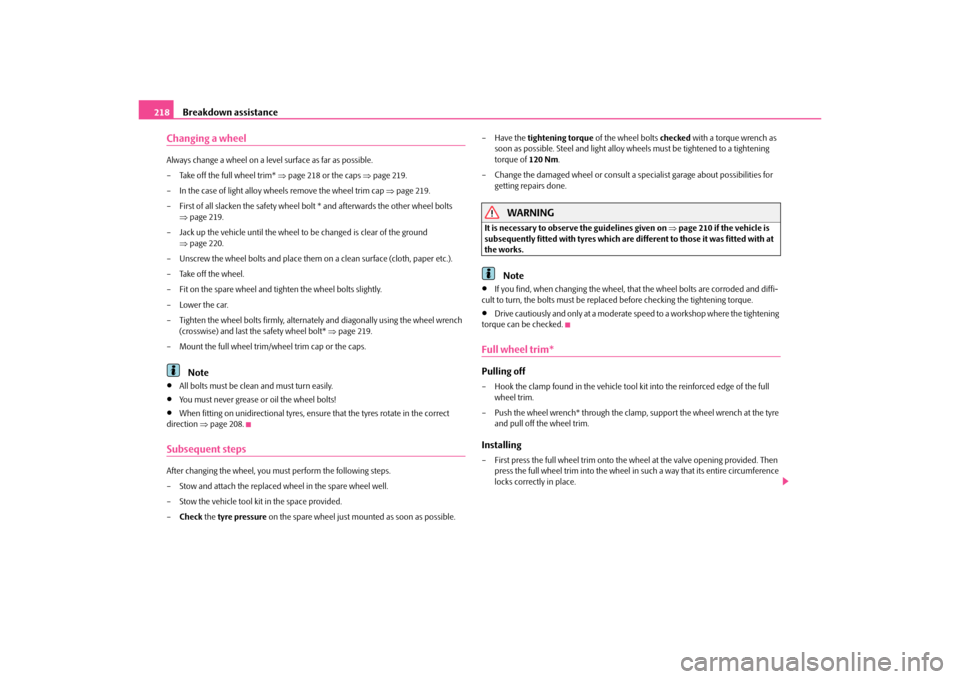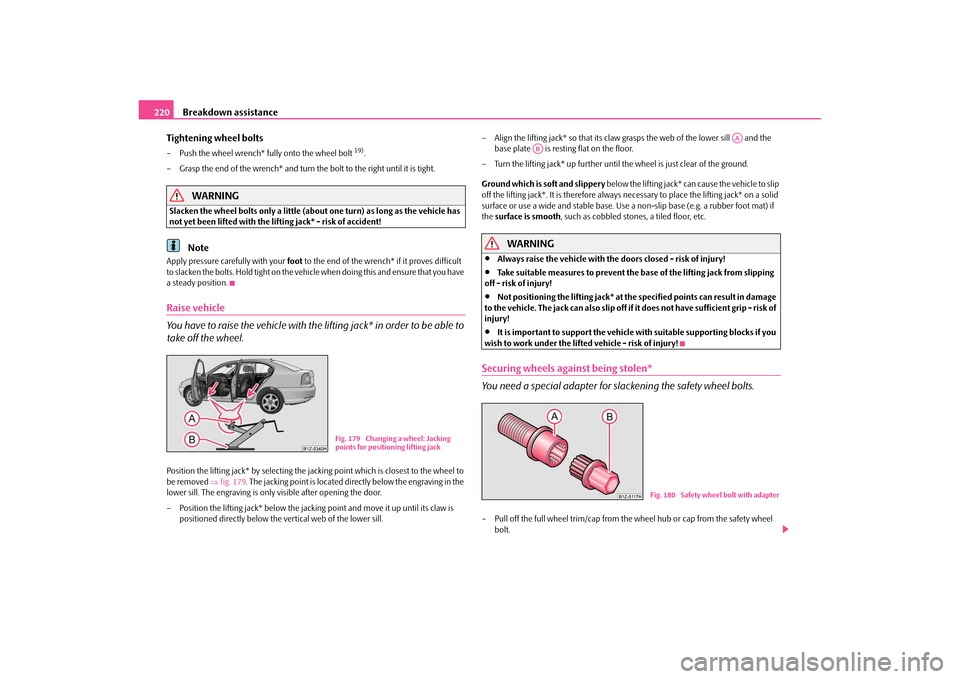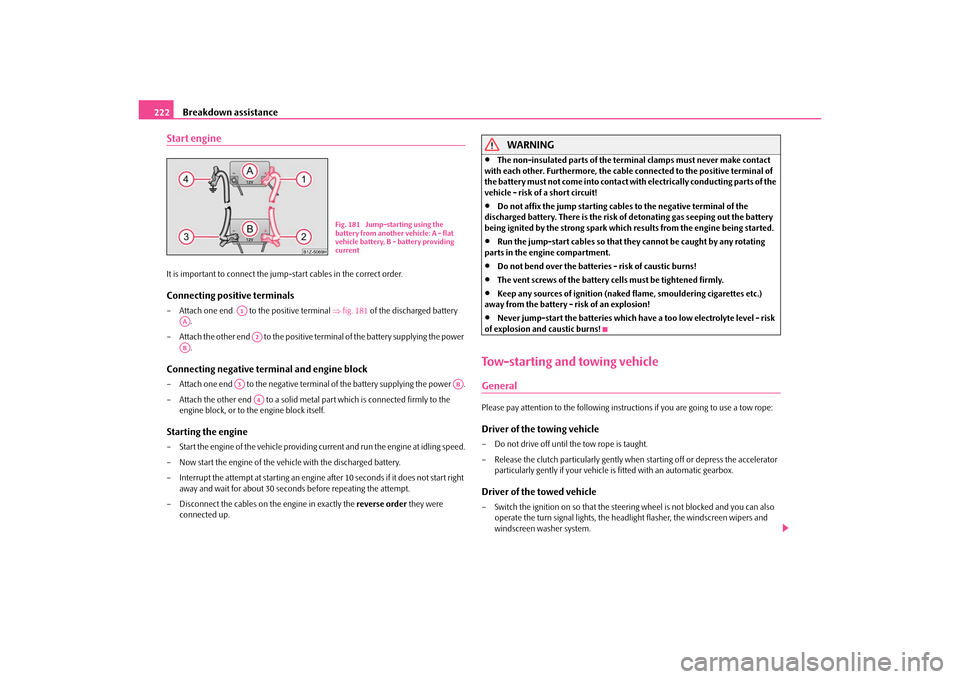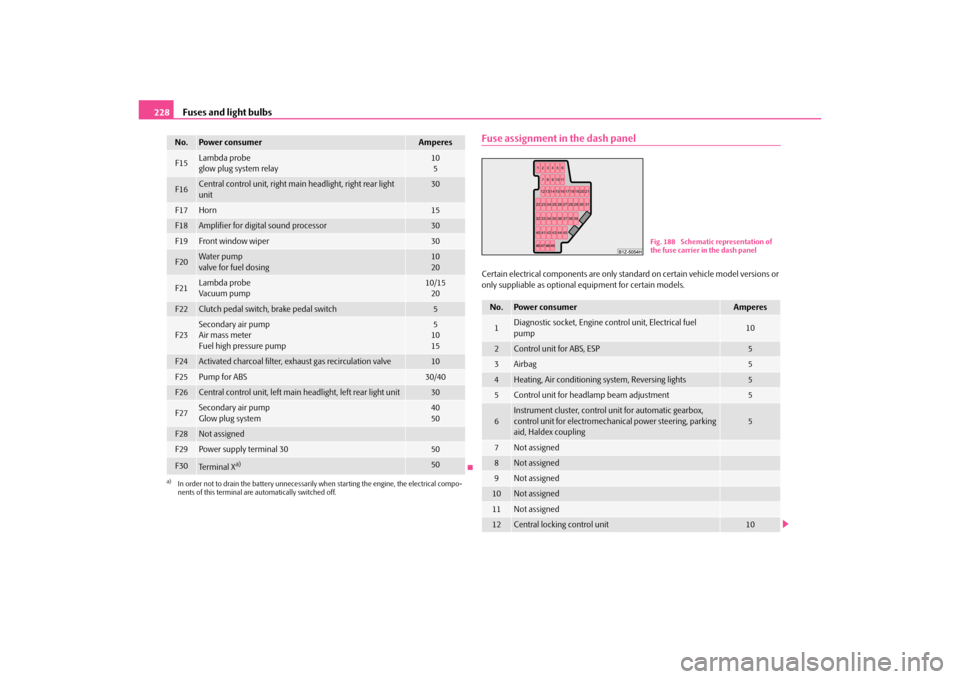lock SKODA OCTAVIA 2010 2.G / (1Z) Manual Online
[x] Cancel search | Manufacturer: SKODA, Model Year: 2010, Model line: OCTAVIA, Model: SKODA OCTAVIA 2010 2.G / (1Z)Pages: 275, PDF Size: 16.43 MB
Page 214 of 275

Wheels and Tyres213
Using the system
Safety
Driving Tips
General Maintenance
Breakdown assistance
Technical Data
Remove the
full wheel trims if you wish to fit snow chains to the wheels.
Observe the national legal requirements relating to the maximum vehicle speed with
snow chains.
WARNING
Please pay attention to the information in the supplied fitting instructions of
the snow chain manufacturer.
Caution
You must take the chains off as soon as you drive on roads which are free of snow. They
adversely affect the handling of your ve hicle, damage the tyres and are rapidly
destroyed.
Note
We recommend that you use snow chains from the Škoda genuine accessories.
Wheel size
Depth (D)
Ty re s i z e
6J x 15
a)
a)Only fit snow chains with links and locks not larger than 15 mm.
47 mm
195/65
6.5J x 15
a)
50 mm
195/65
6J x 16
a)
50 mm
205/55
6J x 17
b)
b)Only fit snow chains with links and locks not larger than 9 mm.
45 mm
205/50
s43s.1.book Page 213 Thursday, May 13, 2010 1:21 PM
Page 216 of 275

Breakdown assistance215
Using the system
Safety
Driving Tips
General Maintenance
Breakdown assistance
Technical Data
Breakdown assistanceBreakdown assistanceFirst-aid box* and Warning triangle* (Octavia)The first-aid box* is attached by a strap to the right-hand side of the luggage compart-
ment.
The warning triangle can be attached to th e trim panel of the rear wall with rubber
straps fig. 172 .
If you wish to equip your ve hicle additionally with a warning triangle, please contact a
specialist garage.
Note
Pay attention to the use-by-date of the contents of the first-aid box.
First-aid box* and warning triangle* (Estate car)For vehicles of the type estate car the firs t-aid box and the warning triangle are housed
in a compartment on the right side in th e luggage compartment. You can open the
compartment by turning the locks in the direction of arrow fig. 173 .
If you wish to equip your ve hicle additionally with a warning triangle, please contact a
specialist garage.
Note
Pay attention to the use-by-date of the contents of the first-aid box.Fire extinguisher*The fire extinguisher is attached with st raps in a holder under the driver seat.
Please read carefully the instructions whic h are attached to the fire extinguisher.
The fire extinguisher must be checked by an authorised person or company annually
(please observe the differing legal requirements).
Fig. 172 Placing of the warning triangle
(Octavia)
Fig. 173 Placing of the warning
triangle (Estate car)
s43s.1.book Page 215 Thursday, May 13, 2010 1:21 PM
Page 217 of 275

Breakdown assistance
216WARNING
If the fire extinguisher is not correctl y attached, in case of sudden manoeuvres
or an accident it can be “thrown” through the interior compartment and cause
injuries.
Note
The fire extinguisher must comply with the relevant and valid legal requirements.
Pay attention to the expiration date of the fire extinguisher. If the fire extinguisher
is used after the expiration date, its proper function is no longer assured.
The fire extinguisher is only supplied in certain countries within the scope of
delivery.
Vehicle tool kitThe vehicle tool kit and the lifting jack* are housed in a box in the spare wheel*
fig. 174 or in the space for the spare wheel. There is also space here for the remov-
able ball for the trailer towing device*. Th e box is attached with a strap on the spare
wheel.
The vehicle tool kit contains the following parts (depending on equipment fitted):
Wire clamps for removing the full wheel trims,
Plastic clip for a wheel bolt cover,
Wheel wrench*,
To w i n g e y e ,
Adapter for the wheel bolts lock.*
Screwdriver* for removing the fog lights
18).
Before placing the lifting jack* back in its storage area, screw in the arm of the lifting
jack fully.
WARNING
The factory-supplied lifting jack* is only intended for your model of vehicle.
On no account attempt to lift a heavier vehicle or other loads - risk of injury!
Ensure that the vehicle tool kit is sa fely attached in the luggage compart-
ment.Note
Ensure that the box is always secured with the strap.Tyre repair kit*The tyre repair kit is intended for the repair of minor tyre defects. The tyre repair kit
contains a compressor, inflation bottle, operating instructions and accessories.
The repair with the tyre repair kit is not at all intended to replace a permanent repair
on the tyre, this repair only serves to reach the next specialist garage. The repair can be
undertaken on the vehicle immediately. Please read the attached instructions care-
fully before the repair.
The tyre repair kit is located in a textile bag. There is a velcro fastener on the underside
of the bag, with which the bag is attached to the floor covering of the luggage compart-
ment in such a way that the side of the bag rests on the right side of the luggage
compartment and on the seat backrest.
Fig. 174 Luggage compartment: storage
compartment for vehicle tool kit
18)Valid for Octavia RS and Octavia Scout.
s43s.1.book Page 216 Thursday, May 13, 2010 1:21 PM
Page 218 of 275

Breakdown assistance217
Using the system
Safety
Driving Tips
General Maintenance
Breakdown assistance
Technical Data
Spare wheel*The spare wheel lies in a well under the floor covering of the luggage compartment and
is fixed in place using special screws fig. 175 .
Before removing the spare wheel, you must take out the box with the vehicle tool kit
box page 216, fig. 174.
One should check the inflation pressure in the spare wheel (at best when generally
checking the tyre air pressures - see sign on the fuel filler flap page 208) to ensure
that the spare wheel is always ready to use.
Temporary spare wheel
A warning label displayed on the rim of the temporary spare wheel indicates that your
vehicle is equippe d with a temporary spare wheel.
Please observe the following notes when driving with a temporary spare wheel:
The warning label must not be covered after installing the wheel.
Do not drive faster than 80 km/h with this spare wheel and pay particular attention
while driving. Avoid accelerating at full throttle, sharp braking and fast cornering.
The inflation pressure for this spare wheel is identical to the inflation pressure of
the standard tyres. The temporary spare wheel R 18 must have an inflation pressure of
420 kPa (4.2 bar)!
Use this spare wheel only to reach the nearest specialist garage as it is not intended
for continuous use.
No other summer or winter tyres must be mounted on the rim of the spare wheel
R 18.
Changing a wheelPreliminary workThe following steps should be carried ou t before actually changing the wheel.
– If it is necessary to change a wheel, park the vehicle as far away as possible from
the traffic flow. The place you choose should be level.
–Have all the occupants get out. While changing a wheel, the occupants of the
vehicle should not stand on the ro ad (e.g. behind a crash barrier).
– Apply the handbrake firmly.
–Engage 1st gear or if your vehicle is fitted with an automatic gearbox, position the
selector lever into position P .
– If a trailer is coupled, uncouple it.
–Take the vehicle tool kit page 216 and the spare wheel* page 217 out of the
luggage compartment.
WARNING
If you find yourself in flowing traffic switch on the hazard warning lights
system and place the warning triangle on the side of the road at the prescribed
distance from your vehicle while observin g all national legal provisions. In this
way you are protecting not only yourself but also other road users.
Never start the engine with the vehicle si tting on the raised jack - danger of
suffering injury.Caution
If you have to change a wheel on a slope fi rst block the opposite wheel with a stone or
similar object in order to secure the vehicle from unexpectedly rolling away.
Note
Comply with the national legal regulations.
Fig. 175 Luggage compartment: Spare
wheel
s43s.1.book Page 217 Thursday, May 13, 2010 1:21 PM
Page 219 of 275

Breakdown assistance
218
Changing a wheelAlways change a wheel on a level surface as far as possible.
– Take off the full wheel trim* page 218 or the caps page 219.
– In the case of light alloy wheels remove the wheel trim cap page 219.
– First of all slacken the safety wheel bolt * and afterwards the other wheel bolts page 219.
– Jack up the vehicle until the wheel to be changed is clear of the ground page 220.
– Unscrew the wheel bolts and place them on a clean surface (cloth, paper etc.).
– Take off the wheel.
– Fit on the spare wheel and ti ghten the wheel bolts slightly.
–Lower the car.
– Tighten the wheel bolts firmly, alternately and diagonally using the wheel wrench (crosswise) and last the safety wheel bolt* page 219.
– Mount the full wheel trim/wheel trim cap or the caps.
Note
All bolts must be clean and must turn easily.
You must never grease or oil the wheel bolts!
When fitting on unidirectional tyres, ensu re that the tyres rotate in the correct
direction page 208.
Subsequent stepsAfter changing the wheel, you must perform the following steps.
– Stow and attach the replaced wheel in the spare wheel well.
– Stow the vehicle tool kit in the space provided.
– Check the tyre pressure on the spare wheel just mounted as soon as possible. – Have the
tightening torque of the wheel bolts checked with a torque wrench as
soon as possible. Steel and light alloy wheels must be tightened to a tightening
torque of 120 Nm.
– Change the damaged wheel or consult a sp ecialist garage about possibilities for
getting repairs done.
WARNING
It is necessary to observe the guidelines given on page 210 if the vehicle is
subsequently fitted with tyres which are di fferent to those it was fitted with at
the works.
Note
If you find, when changing the wheel, that the wheel bolts are corroded and diffi-
cult to turn, the bolts must be replaced before checking the tightening torque.
Drive cautiously and only at a moderate speed to a workshop where the tightening
torque can be checked.
Full wheel trim*Pulling off– Hook the clamp found in the vehicle tool ki t into the reinforced edge of the full
wheel trim.
– Push the wheel wrench* through the clamp, support the wheel wrench at the tyre and pull off the wheel trim.Installing– First press the full wheel trim onto the wheel at the valve opening provided. Then
press the full wheel trim into the wheel in such a way that its entire circumference
locks correctly in place.
s43s.1.book Page 218 Thursday, May 13, 2010 1:21 PM
Page 221 of 275

Breakdown assistance
220
Tightening wheel bolts
– Push the wheel wrench* fully onto the wheel bolt
19).
– Grasp the end of the wrench* and turn the bolt to the right until it is tight.
WARNING
Slacken the wheel bolts only a little (about one turn) as long as the vehicle has
not yet been lifted with the lifting jack* - risk of accident!
Note
Apply pressure carefully with your foot to the end of the wrench* if it proves difficult
to slacken the bolts. Hold tight on the vehicl e when doing this and ensure that you have
a steady position.Raise vehicle
You have to raise the vehicle with the lifting jack* in order to be able to
take off the wheel.Position the lifting jack* by selecting the ja cking point which is closest to the wheel to
be removed fig. 179 . The jacking point is located directly below the engraving in the
lower sill. The engraving is only visible after opening the door.
– Position the lifting jack* below the jacking point and move it up until its claw is
positioned directly below the vertical web of the lower sill. – Align the lifting jack* so that its claw
grasps the web of the lower sill and the
base plate is resting flat on the floor.
– Turn the lifting jack* up further until the wheel is just clear of the ground.
Ground which is soft and slippery below the lifting jack* can cause the vehicle to slip
off the lifting jack*. It is therefore always necessary to place the lifting jack* on a solid
surface or use a wide and stable base. Use a non-slip base (e.g. a rubber foot mat) if
the surface is smooth, such as cobbled stones, a tiled floor, etc.
WARNING
Always raise the vehicle with the doors closed - risk of injury!
Take suitable measures to prevent the ba se of the lifting jack from slipping
off - risk of injury!
Not positioning the lifting jack* at the specified points can result in damage
to the vehicle. The jack can al so slip off if it does not have sufficient grip - risk of
injury!
It is important to support the vehicle with suitable supporting blocks if you
wish to work under the lifted vehicle - risk of injury!
Securing wheels against being stolen*
You need a special adapter for sl ackening the safety wheel bolts.– Pull off the full wheel trim/cap from the wheel hub or cap from the safety wheel
bolt.
Fig. 179 Changing a wheel: Jacking
points for positioning lifting jack
AA
AB
Fig. 180 Safety wheel bolt with adapter
s43s.1.book Page 220 Thursday, May 13, 2010 1:21 PM
Page 223 of 275

Breakdown assistance
222
Start engineIt is important to connect the jump -start cables in the correct order.Connecting positive terminals– Attach one end to the positive terminal fig. 181 of the discharged battery
.
– Attach the other end to the positive term inal of the battery supplying the power
.Connecting negative terminal and engine block– Attach one end to the negative termin al of the battery supplying the power .
– Attach the other end to a solid metal part which is connected firmly to the
engine block, or to the engine block itself.Starting the engine– Start the engine of the vehicle providing current and run the engine at idling speed.
– Now start the engine of the vehicle with the discharged battery.
– Interrupt the attempt at starting an engine after 10 seconds if it does not start right
away and wait for about 30 seconds before repeating the attempt.
– Disconnect the cables on the engine in exactly the reverse order they were
connected up.
WARNING
The non-insulated parts of the terminal clamps must never make contact
with each other. Furthermore, the cable connected to the positive terminal of
the battery must not come into contact with electrically conducting parts of the
vehicle - risk of a short circuit!
Do not affix the jump starting cables to the negative terminal of the
discharged battery. There is the risk of detonating gas seeping out the battery
being ignited by the strong spark which results from the engine being started.
Run the jump-start cables so that they cannot be caught by any rotating
parts in the engine compartment.
Do not bend over the batteries - risk of caustic burns!
The vent screws of the battery cells must be tightened firmly.
Keep any sources of ignition (naked flame, smouldering cigarettes etc.)
away from the battery - risk of an explosion!
Never jump-start the batteries which ha ve a too low electrolyte level - risk
of explosion and caustic burns!
Tow-starting and towing vehicleGeneralPlease pay attention to the following instru ctions if you are going to use a tow rope:Driver of the towing vehicle– Do not drive off until the tow rope is taught.
– Release the clutch particularly gently wh en starting off or depress the accelerator
particularly gently if yo ur vehicle is fitted with an automatic gearbox.Driver of the towed vehicle– Switch the ignition on so that the steeri ng wheel is not blocked and you can also
operate the turn signal lights, the headlight flasher, the windscreen wipers and
windscreen washer system.
Fig. 181 Jump-starting using the
battery from another vehicle: A - flat
vehicle battery, B - battery providing
current
A1
AA
A2
AB
A3
AB
A4
s43s.1.book Page 222 Thursday, May 13, 2010 1:21 PM
Page 225 of 275

Breakdown assistance
224
Front towing eye for Octavia RS and Octavia Scout
The towing eye is stored in th e box for the vehicle tool kit.Fig. 183 Front bumper Octavia RS: Protective grille / Octavia Scout: CoverOctavia RS– Guide one finger into the opening of the grille fig. 183 .
– Unlock the cover by pulling it in direction and remove it.
– Screw in the towing eye by hand to the left up to the stop page 223, fig. 182 -
right and tighten it as much as possible.
– After screwing out the towing eye, reinsert the cover and lock it in place. The cover must engage firmly.Octavia Scout– Press on the upper part of the cover and remove it.
– Screw in the towing eye by hand to the left up to the stop page 223, fig. 182 -
right and tighten it as much as possible. For tightening, we recommend that you
use for example the wheel wrench*, the lashing eye of another vehicle or a similar
object which you can push through the eye.
– After screwing out the towing eye, reinsert the cover and lock it in place. The cover must engage firmly.
Caution
The towing eye must always be screwed in fully and firmly tightened, otherwise the
towing eye can tear when towing in or tow-starting.Rear towing eyeFig. 184 Rear bumper: Remove cover / re ar bumper: Installing the towing eye– Unlock the bottom part of the cover by pulling it downwards in direction of arrow
fig. 184 .
– Unlock the upper part of the cover by pulling it in direction of arrow and remove it.
– Screw in the towing eye by hand to the left up to the stop fig. 184 - right and
tighten it as much as po ssible. For tightening, we recommend that you use for
example the wheel wrench*, the lashing eye of another vehicle or a similar object
which you can push through the eye.
– In order to reinstall the cover after screwing out the towing eye, first of all insert the
upper part of the cover and then press in the lower part. The cover must engage
firmly.
Caution
The towing eye must always be screwed in fully and firmly tightened, otherwise the
towing eye can tear when towing in or tow-starting.
AA
A1
AB
A1
A2
s43s.1.book Page 224 Thursday, May 13, 2010 1:21 PM
Page 228 of 275

Fuses and light bulbs227
Using the system
Safety
Driving Tips
General Maintenance
Breakdown assistance
Technical Data
Fuse cover in engine compartmentOn some vehicles, the battery cover must be removed before removing the fuse cover
page 203.Removing fuse cover– Move the circlips fig. 186 as far as the stop, the symbol
appears behind the
circlip and remove the cover.
Installing fuse cover– Position the fuse cover on the fuse box and push the circlips as far as the stop -
the symbol
is visible behind the circlip.
Caution
When unlocking and locking the fuse cover, it must be pressed on the sides to the
box, otherwise damage can occur to the locking mechanism.
Carefully position the fuse cover in the engine compartment. If the cover was not
correctly positioned, water can get into the fuses and this results in a damage to the
vehicle!
Fuse assignment in engine compartmentCertain electrical components are only stan dard on certain vehicle model versions or
only suppliable as optional equipment for certain models.
Fig. 186 Fuse cover in engine compart-
ment
AA
AA
No.
Power consumer
Amperes
F1
Not assigned
F2
Control unit for automatic gearbox DQ 200
30
F3
Measuring circuit
5
F4
Valves for ABS
30/20
F5
Control unit for automatic gearbox
15
F6
Instrument cluster, windshield wiper lever and turn signal
light lever
5
F7
Power suppy terminal 15, Starter
40
F8
Radio
15
F9
Phone
5
F10
Engine control unit, Main relay
5/10
F11
Control unit for auxiliary heating
20
F12
Control unit for CAN databus
5
F13
Engine control unit
15/30
F14
Ignition
20
Fig. 187 Schematic representation of
fuse carrier in engine compartment
s43s.1.book Page 227 Thursday, May 13, 2010 1:21 PM
Page 229 of 275

Fuses and light bulbs
228
Fuse assignment in the dash panelCertain electrical components are only stan dard on certain vehicle model versions or
only suppliable as optional equipment for certain models.
F15
Lambda probe
glow plug system relay
10
5
F16
Central control unit, right main headlight, right rear light
unit
30
F17
Horn
15
F18
Amplifier for digital sound processor
30
F19
Front window wiper
30
F20
Wa te r pump
valve for fuel dosing
10
20
F21
Lambda probe
Vacuum pump
10/15 20
F22
Clutch pedal switch, brake pedal switch
5
F23
Secondary air pump
Air mass meter
Fuel high pressure pump
5
10
15
F24
Activated charcoal filter, ex haust gas recirculation valve
10
F25
Pump for ABS
30/40
F26
Central control unit, left main headlight, left rear light unit
30
F27
Secondary air pump
Glow plug system
40
50
F28
Not assigned
F29
Power supply terminal 30
50
F30
Te r m i n a l X
a)
50
a)In order not to drain the battery unnecessarily wh en starting the engine, the electrical compo-
nents of this terminal are automatically switched off.No.
Power consumer
Amperes
No.
Power consumer
Amperes
1
Diagnostic socket, Engine co ntrol unit, Electrical fuel
pump
10
2
Control unit for ABS, ESP
5
3
Airbag
5
4
Heating, Air conditioning system, Reversing lights
5
5
Control unit for headla mp beam adjustment
5
6
Instrument cluster, control unit for automatic gearbox,
control unit for electromecha nical power steering, parking
aid, Haldex coupling
5
7
Not assigned
8
Not assigned
9
Not assigned
10
Not assigned
11
Not assigned
12
Central locking control unit
10
Fig. 188 Schematic representation of
the fuse carrier in the dash panel
s43s.1.book Page 228 Thursday, May 13, 2010 1:21 PM